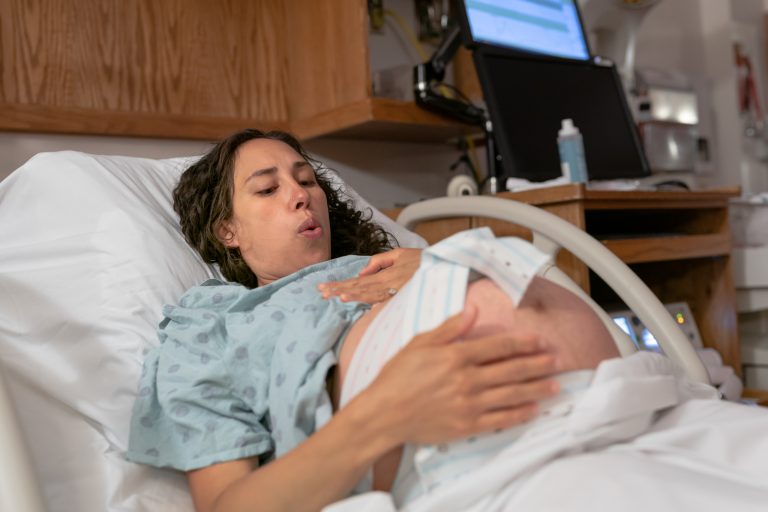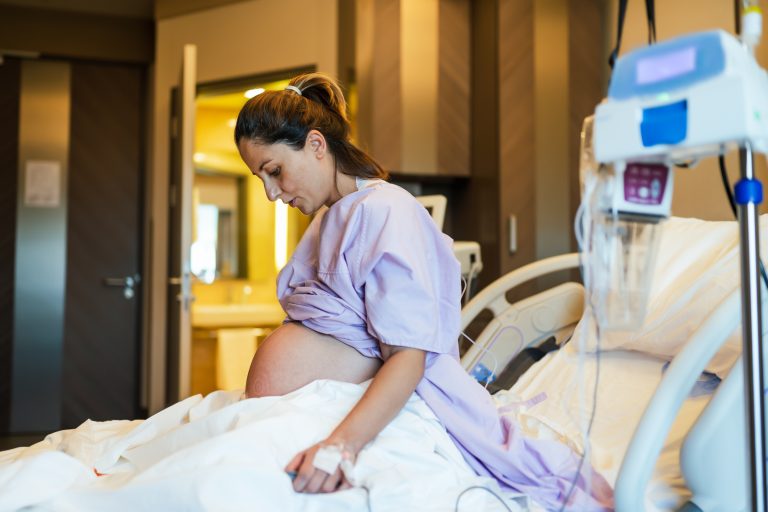In most cases, vaginal births or natural births can be safer than cesarean births, more commonly known as C-sections, but that doesn’t mean that C-sections aren’t safe. C-sections are a common procedure and sometimes may be a better and safer delivery method for the parent and baby depending on the situation.
There are a lot of factors to consider when deciding if you want to have a C-section or vaginal birth. Knowing the differences and benefits of C-section vs. vaginal birth is important when planning for your delivery at The Mother Baby Center.

Find support for every delivery option at The Mother Baby Center.
Key differences of C-section vs. vaginal birth
The key difference between a C-section and a vaginal birth is how the baby is delivered. In a cesarean delivery, the baby will be delivered through an incision in the mother’s abdomen and uterus. Where’s in a vaginal delivery, the baby will be born through the birth canal. Some other differentiators include the labor progress, recovery time, and pain level.
- Duration of labor: The duration of being in labor may be vastly different for the two methods, especially if you have a planned C-section. C-sections typically last up to 45 minutes to an hour. Where’s the act of being in labor for vaginal births can last up to 12-14 hours.
- Recovery time: For a full recovery from C-sections, it is typically 6-8 weeks, and you may need to stay at the hospital for a longer time. Where’s for vaginal births, full recovery can be expected at around six weeks and a shorter hospital stay.
- Pain level: Pain is subjective because not everyone experiences pain the same way. However, in a C-section, you should feel little to no pain as you will have been under general anesthesia or numbed. But your recovery may be more painful than compared to someone who had a vaginal birth experience.

Learn what to include in your birth plan to feel prepared no matter which type of delivery you choose.
Pros and cons of vaginal birth
Vaginal birth is usually the preferred delivery method amongst pregnant patients and for good reason. When it comes to vaginal birth, there are multiple options to choose from such as water births, an experience with little to no medical intervention, and more.
There are also many benefits of a vaginal birth. It is also known to be the less risky option and tends to be easier on a woman’s body compared to C-sections. While the reasons to have a vaginal birth are quite clear, there are still cons to this method.
- Pro: The recovery time for vaginal births is typically shorter than C-sections. A vaginal birth recovery can be anywhere from 2-6 weeks, whereas C-sections can take up to 6-8 weeks for a full recovery.
- Pro: A vaginal birth experience means that the mother, baby, and family can have a more unique and personalized experience.
- Con: In short, vaginal births can be painful. However, there are medical interventions that can help reduce the pain intensity of childbirth if that is something the patient is interested in.
- Con: The process of being in labor can be prolonged due to various factors such as the parent being tired or the baby being in the wrong position.
Pros and cons of C-section
C-sections are typically recommended for expecting patients that have a high-risk pregnancy, deliver multiple babies (e.g., twins), or have a baby in a breech position. Just like vaginal births, there are both pros and cons to having a C-section birth.
- Pro: C-sections are typically scheduled with your doctor so you will know the time and day. It gives families the ability to plan and prepare for the delivery without feeling rushed.
- Pro: C-section births are a good and lifesaving option if vaginal birth isn’t an option, or the parent and baby are in danger.
- Con: People that have a C-section typically stay in the hospital longer.
- Con: Having a C-section means that there may be an increased risk for complications in later pregnancies and you may not have the option to have a vaginal birth in those following pregnancies. It is important to talk to your provider about this if you have any questions or concerns.

What happens during an emergency C-section?
An emergency C-section happens when there is a risk to the parent or baby and can happen whether you were originally planning to have a C-section or vaginal birth. Although what happens during an emergency C-section can be very similar to a scheduled C-section, everyone will have a different experience based on their medical history and needs. Recovery for emergency C-sections will be about the same as scheduled C-sections.
Can you choose to have a C-section?
Despite it being a safe and common procedure, there are more risks to C-sections than there are risks to vaginal childbirth. This is why C-sections are typically not recommended unless necessary. However, there are still elective C-section benefits that may cause patients to choose to deliver via C-section by personal choice. Below are a few non-medical reasons for C-sections that parents might choose this option over a vaginal birth.
- Control: C-sections give expecting parents the flexibility to plan and prepare for the day their baby is born. It will also reduce anxiety around waiting for labor to start.
- Fear of pain: Fear of pain is another common reason expecting parents may choose to have a C-section instead. Having a C-section means that you get to avoid the pain and labor that comes with a vaginal birth.
- Anxiety: Labor and vaginal birth can be anxiety-inducing for some women and in return prolong the labor process, making it unsafe.

The Mother Baby Center provides expert specialty care to deliver peace of mind at every stage of pregnancy.
C-section vs. vaginal birth: which is more painful?
Both C-section births and vaginal births can be painful but for different reasons and can happen at different times during the pregnancy journey. Generally, women that have C-sections won’t feel pain during the surgery due to the numbing or anesthesia, but recovery after birth is where they will start feeling the most pain as their incision recovers.
For vaginal births, most of the pain will happen during the labor process. However, pain can vary depending on whether the person giving birth chooses to give birth with medical intervention (e.g., epidural) or without. Parents that decide to give birth with little to no medical intervention will feel the most pain during labor as they will be feeling every sensation. But if the other route is chosen and an epidural is given, it can help lessen the pain of labor.
Is it possible to have a vaginal birth after a C-section?
Vaginal birth after a C-section (VBAC) is possible. However, there are a couple of deciding factors that will impact your ability to have a VBAC. These factors are the type of incision made during a C-section, if there were other surgeries done on the abdomen area, the baby’s position and other health concerns.
What are the risks of vaginal birth after c-section
Because everyone’s situation and experience are so different, it is important to consult your OB/GYN about the personal risks of a VBAC when planning for your next delivery at The Mother Baby Center. Some risks of VBAC are infections, blood loss, uterine rupture and more.
Although a rare occurrence, a uterine rupture, the opening of an old C-section scar, is still a risk to having a VBAC. A uterine rupture is a medical emergency and will require an emergency C-section to be performed because of the harm it can cause to the parent and baby.

Learn what to expect during the fourth trimester and the initial postpartum period for your recovery and your baby’s health.
What to expect during postpartum recovery
Regardless of if you’ve had a vaginal birth or C-section, postpartum recovery can be hard and stressful for everyone. Your hormones changing, having a new baby to care for, and your body trying to recover are all very emotionally and physically draining. Knowing what to expect can help prepare you for it all.
Vaginal birth recovery
The recovery period for vaginal births typically lasts a full four to six weeks. However, recovery can vary depending on if there were any vaginal tears during labor. If you had a painful vaginal birth that created vaginal tears that required stitches, you can expect the stitches to dissolve after the first two weeks of recovery.
Some other symptoms you may experience during the recovery period are vaginal tenderness and soreness, bleeding, discharge as your uterus sheds the thick lining it maintained during pregnancy, enlarged breasts, tiredness and more. Checking in with your doctor about healing and being mindful of signs of infection are important during the healing stage regardless of the delivery method.
C-section recovery
Postpartum recovery from a C-section birth is usually longer and for a full recovery, it can take up to 6-8 weeks. Women that had C-section births can expect to stay in the hospital longer and have restrictions on bending and lifting heavy items.
Although most symptoms such as enlarged breasts and vaginal bleeding will stay the same for C-section recoveries, women that had a C-section birth can expect to feel pain, soreness, and tenderness around their incision area. Patients may experience C-section digestive problems temporarily and have sensitive stomachs. If an emergency C-section was performed after laboring, overall body pain, soreness, and vaginal pain after a C-section can be expected.
Have a safe delivery for your baby at The Mother Baby Center
At The Mother Baby Center, we understand how stressful it can be to plan for your due date. It is important to get all the information and know the key differences, pros and cons of each delivery method when making your decision.
Whether you want to have a C-section or a vaginal birth experience, our team of experts is prepared for every possible situation. We are dedicated to providing a personalized experience for our patient families and offer six different delivery options. Learn more about all the different delivery options we offer and plan to deliver your baby here at The Mother Baby Center.